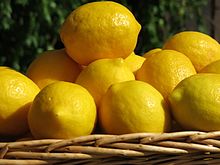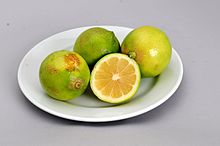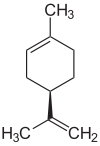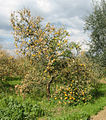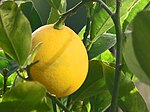lemon
| lemon | ||||||||||||
|---|---|---|---|---|---|---|---|---|---|---|---|---|
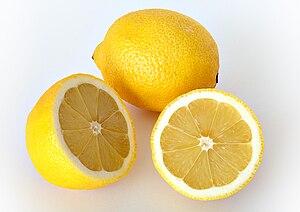
Whole and sliced lemon |
||||||||||||
| Systematics | ||||||||||||
|
||||||||||||
| Scientific name | ||||||||||||
| Citrus × limon | ||||||||||||
| ( L. ) Osbeck |
The lemon or lime (from Arabic ليمون, DMG laimūn "lemon") is the approximately fist-sized fruit of the lemon tree ( Citrus × limon ) from the genus of citrus plants ( Citrus ). It is a group of varieties that arose from a cross between bitter orange ( Citrus × aurantium ) and citron lemon ( Citrus medica ), probably in northern India . Around the year 1000, the first reliable evidence can be found both in China and in the Mediterranean region .
The evergreen trees produce elongated oval fruits (the lemons) with yellow or green-yellow peel. The juicy, sour pulp contains about 3.5-8% citric acid , and a lot of vitamin C . Juice, citric acid, essential oil and pectin are obtained from lemons .
Surname
The name lemon used to refer to the lemon . It was not until the late Middle Ages that the name was transferred to the lemon in some languages. However, in other languages such as English , the term citron still refers to the citron, while the lemon is referred to with the word lemon , borrowed from Arabic . However, the word limone was a widespread term for lemon in the German language for centuries and it still is in some regions of Austria . The word lemonade , borrowed from the French language , originally only referred to a soft drink made from lemons. In some cases, the word lemon is also used as a collective term for the sour-tasting citrus fruits lime, lemon and lime .
description
The lemon grows as a small to medium-sized, evergreen tree. Compared to other citrus plants, they are fast-growing and large. Young shoots in particular are covered with small, thin thorns. The shoot is reddish, the buds are also pink, the otherwise white petals on the underside pink to purple.
The leaves are oblong-oval to broadly lanceolate, pointed, slightly serrated or notched on the edge. The petiole is somewhat widened (winged), the leaf blade is clearly separated from the petiole (unifoliate leaf).
The sometimes putrid scented flowers appear distributed throughout the year in little-flowered inflorescences. They have a diameter of about 20 to 30 millimeters and consist of five fused sepals and five free petals . The ovary is thick cylindrical and goes into the pen over. The 20 to 40 stamens are fused with the stamens to form several groups.
Pollination is usually done by insects, but wind pollination and self-fertilization through direct contact of the stamens with the stigma are also common in citrus. Parthenocarpy, i.e. fruit without fertilization, results in seedless fruits, but also because citrus is partly male-sterile or the stigma is not fertile. Often flowers appear in which the gynoeceum is stunted, that is, functionally male.
The fruit ( hesperidium ) consists of eight to ten segments that are filled with light yellow sap sacs . Each segment is surrounded by a thin membrane ( endocarp ), the whole fruit by a two-part shell. The inner layer of the shell is white ( mesocarp , albedo), the outer layer is green when ripe ( exocarp , flavedo), and in subtropical areas in winter it is also yellow. Lemons that are marketed in Europe have mostly been treated so that the peels are always yellow. There are numerous oil glands in the bowl, it gives off an aromatic scent. The leaves also have the typical lemon smell. There is usually a small protuberance at the top of the fruit. The seeds are relatively small, smooth and pointed. Inside they are white. About 10 to 15% of the seeds are polyembryonic .
The number of chromosomes is 2n = 18.
European cultivation and kitchen history
Lemons have been found in Europe since the 13th century, initially in Sicily and Spain , and since the second half of the 16th century also in Germany. Wilhelmina Jashemski assumes, however, that lemons were already grown in the Roman Empire. In the villa of Poppaea Sabina in Oplontis , which was excavated in 1964 , they could be detected on the basis of wood residues and the type of extension. Lemons are also depicted on murals in Pompeii , according to Jashemski . Helena Attlee, however, takes the view that it was citron lemons that were imported by Jews who immigrated to Calabria. There were ritual reasons for this: At the Feast of Tabernacles , the arba'a minim are worn to the services in the synagogue, based on the ancient harvest festival . In addition to palm branches, three myrtle branches and two brook willow branches, they also consist of the etrog , a type of citron. The bitter orange , which is more robust in cultivation, and later the more difficult to cultivate lemon, were only introduced to Sicily after the year 831 as a result of the Arab conquests. With the rainy winters and the dry summers, Sicily is actually not ideal for growing citrus fruits. However, based on the irrigation systems still in existence from Roman times, Arab settlers developed irrigation methods that allowed cultivation. Ibn Hauqal , who also visited Sicily on his long travels, describes in his book of the image of the earth , written down in 977, the extensive gardens in which orange and lemon trees grew due to the introduced irrigation methods.
In the Middle Ages, the use of lemons in cooking was limited to the extreme south of Europe. In the 16th century, lemon juice was still a novelty as a seasoning for fish or poultry at the court of the English King Henry VIII .
Renaissance

Wealthy Italian families had special collections of citrus plants as early as the 16th century and thus in the Renaissance , in which, comparable to a cabinet of curiosities, even more unusual varieties and mutations were maintained. The collection of the Medici family, which dates back to 1537, the year in which Cosimo I de 'Medici came to power and began to rebuild the family's country estate, Villa Medici von Castello , was considered particularly outstanding . Niccolò Tribolo , in charge of the garden design, used citrus plants, which symbolized the golden apples of the Hesperides from the ancient Herakles saga, in order to underline a connection between the Medici family and the heroic virtues of Heracles. Initially, only citrus plants were cultivated in the villa's garden, which were regularly grown in Sicily and southern Italy, but even more unusual varieties were cultivated under Francesco I. de 'Medici . The French naturalist Pierre Belon , who visited the garden between 1546 and 1549, describes it as a garden that is decorated like a carpet with oranges and lemon plants. The sensitive citrus plants found winter protection in the north of Tuscany in the so-called limonaia (literally translated: lemon house ), the Italian variant of the orangery . The Italian Renaissance garden found imitators in France, Germany and England, but initially more in its design elements than with its planting.
The cookbook Opera by Bartolomeo Scappi points to the comparatively minor role that lemon played in Renaissance cuisine . Scappi joined Pope Paul III in 1534 . in the service of the Vatican kitchen and worked as personal cook for several popes until 1576: Julius III. , Paul IV and Pius IV , Pius V and Gregor XIII. With his cookbook “Opera” , published in 1570, he passed on around 1000 recipes of Renaissance cuisine to posterity. Scappi mainly used bitter oranges in his recipes.
Baroque

The baroque garden evolved from the renaissance garden, the earliest baroque gardens emerged in France. Princely baroque gardens had a more representative function than the Renaissance gardens: lemon plants were popular because of their symbolism as the apples of the Hesperides, as a symbol of immortality (at the same time blooming and bearing fruit), but also because of their fragrance and taste. In the 17th and 18th centuries, a real orangery culture also emerged in the northern countries of Europe.
The first large-scale attempt to work up the difficult taxonomy of citrus fruits also fell in the Baroque period. The Jesuit and botanist Giovanni Baptista Ferrari published “ Hesperides, sive, De Malorum aureorum cultura et usu ” (Hesperides, or, the cultivation and use of the golden apples) in 1646 . The garden historian Helena Attlee calls it a typical product of the scientific revolution that took place during this period and which separated from the previously accepted worldview of antiquity and laid the basis for modern natural science. Instead of building on ancient texts, Ferrari used empiricism : with the support of his friend Cassiano dal Pozzo , he sent questionnaires to citrus fruit growers all over Italy. Among the recipients were princes, cardinals, peasants and gardeners. It is probably thanks to Pozzo's connections that Ferrari received so many answers to his questions. His questionnaire asked for information about the name of the plant, the origin of the name, the appearance of the tree, the leaves, the flower and the fruit as well as their use. In its evaluation, Ferrari divided citrus plants into three strict categories: citrus lemons, lemons and oranges. Ferrari's work was illustrated by the Danish painter and graphic artist Cornelius Bloemaert , who lived and worked in Rome.
In the fine arts, lemons have appeared as part of dessert or breakfast still life since the late 16th century . Willem Kalf (1619–1693) or Jan Davidsz. de Heem (1606–1683 / 84) artfully place lemons, peeled in spirals, next to or in precious cups and glasses, presumably to flavor the wine. The peeled lemons were placed directly in the wine. Lemon or lemon juice are used in numerous recipes of the early modern era. According to an “instruction on how to make a large panquet according to the French style” from 1679, crispy roasted game and poultry should be “served in small bowls, pommerantzen, lemon, olives and the like”. The Berlin botanist Johann Sigismund Elsholtz mentions citrus fruits, including lemons, in 1682 in his Dieteticon, a cookery and diet book.
The paintings of citrus fruits that Bartolomeo Bimbi made for Cosimo III between 1699 and 1715 are of particular garden historical value . de 'Medici and which were intended for the Villa Medici La Topaia . They were part of an assignment to display any fruit that was grown in Tuscany. As part of this commission, four paintings were created, depicting a total of 116 carefully labeled varieties of citrus fruits.
18th and 19th centuries
Lemons and the scurvy

The vitamin deficiency disease scurvy was particularly common among seafarers during long voyages. Doctors had observed as far back as the 17th century that citrus consumption led to faster recovery. Vitamins were still unknown, the healing effect was attributed to the acidity of the fruit. The Scottish ship's doctor James Lind finally carried out one of the world's first clinical investigations in 1747 and was thus able to demonstrate the therapeutic effect of lemon juice in the treatment of scurvy. However, it took another 40 years for the British Admiralty to accept his findings and make it a requirement that all seafarers protect themselves from this disease by consuming one ounce of sugar with one ounce of lemon juice a day. This new regulation had dramatic effects: while in 1780 seamen suffering from scurvy were still admitted to the Royal Hospital in Halsar in 1457, there were only two cases in 1806.
Lemon juice, or lemons preserved in salt water, were soon adopted by the navy of many countries as a means of treating scurvy. After 1845, the British Admiralty gradually replaced the lemons obtained from Sicily and Malta with limes grown on British plantations in the West Indies : It was still believed that the scurvy-healing properties of lemon juice were based on its acidity, and lime juice was even more acidic than lemon juice. In fact, fresh lime juice only has half as much vitamin C as lemon juice, and due to the storage of the lime juice used in the British Navy, it only contained extremely small amounts of vitamin C. This difference between lemon juice and lime juice initially went undetected because the amount around In the middle of the 19th century, the increasing use of steamships meant that seafarers were usually too short on the high seas to develop scurvy. Exceptions to this were seamen who were on whalers or members of a polar expedition. The crucial difference between lemon and lime juice was revealed as early as 1875 on the British Arctic expedition led by George Nares . Nares tried to reach the North Pole via Greenland, but the expedition had to be canceled after the expedition members fell ill with scurvy, although they all ate the prescribed lime juice ration every day. However, this in no way led to a change in the regulations: The Jackson Harmsworth Expedition 1894–1897, Scott's Discovery Expedition 1901–1904 and the Terra Nova Expedition 1910–1913 were also affected by scurvy . Vitamin C as the decisive active component was not discovered until 1928 by the Hungarian Albert Szent-Györgyi and the American Charles Glen King .
Sicily: Lemons and Mafia
Sicily developed into a major producer of lemons in the 19th century. In the 18th century, the British Admiralty initially got its lemon juice from Spain, after the sea battle at Abukir and the subsequent conquest of Malta by British troops in 1798, Malta and Sicily became the main suppliers. When the British Admiralty switched to the cheaper lime juice from the West Indies around the middle of the 19th century, trade relations between Sicily and North America were already so extensive that this did not have any far-reaching consequences for the Sicilian economy: the first lemons from Sicily were brought to North America in 1807 and in 1830 ships loaded with oranges and lemons from Sicily ran into New York all year round.
Growing lemons was more economical than growing oranges because of the higher production volume. Lemons also survived the crossing to North America better: before the steamship journey began, a sailing freighter from Messina or Palermo to New York took an average of 45 days. Accordingly, lemons accounted for two thirds of Sicily's citrus production. The profit margin from this cultivation in 1860 was also higher than any other agricultural production in Europe. The approximately 100 square kilometer Conca d'Oro plain , in which the city of Palermo is also located, developed into the center of cultivation in Sicily .
However, extensive investments were necessary before citrus fruits could be grown on the poor and often stony soils of the Conca d'Oro. Often it first had to be planted with opuntia to loosen the soil. Walls had to be built around the plantations to protect the young trees from both cold winds and thieves, wells had to be dug and irrigation systems installed, paths had to be built to the plantations and sheds built there to store tools and harvested fruits. Once the trees were planted, it took about eight years for them to bear fruit in any appreciable number. It was in this environment that the forms of protection racket that are associated with the mafia today emerged. It was the wealthier among the lemon growers who offered their neighbors to guard their plantations, who secured them access to water in return for payment of money, and who also made it dependent on payments whether the harvest was loaded on the ships to North America on time or whether the harvest remained lying on the harbor docks unnoticed.
use
Lemons are mainly used as food, but also as an ornamental plant. Lemon juice was occasionally used as a contraceptive .
In addition to the juice, the grated zest of the lemon is often used as a flavoring ingredient in the kitchen and in baking , see lemon yellow . Only the peel of an untreated lemon is suitable for consumption; Citrus fruits are usually covered with a waxy protective layer before being transported and sprayed with preservatives such as 2-phenylphenol (E231) or thiabendazole (E233). Earlier also came biphenyl (E230) are used. Eating such pods is considered unhealthy. Untreated lemon peel is processed into lemon oil .
The leaves of kaffir lime , sometimes referred to as "lemon leaves", are mainly used in Thai cuisine .
ingredients
Like all citrus fruits, the lemon is rich in phosphorus and pectin . 100 grams of lemon contain on average:
| energy | water | fat | potassium | Calcium | magnesium | phosphorus | vitamin C |
|---|---|---|---|---|---|---|---|
| 151–235 kJ (35–56 kcal ) | 84-90 g | 0.6 g | 149 mg | 11 mg | 28 mg | 20 mg | 51 mg |
| 7% * | 1 %* | 9% * | 3% * | 71% * |
* Proportion of the daily requirement of an adult
Medicinal plant
The following medicinal drugs are used:
Lemon oil, d. H. the essential oil from the fresh fruit peels. The lemon peel, d. H. the dried or fresh outer layer of the pericarp.
Active ingredients
Essential oil with lime (65–70%) and the typical citral smell .
In the fruit peels, the bitter-tasting flavonoids neohesperidin and naringenin , the non-bitter rutin ; Hydroxycoumarins , furanocoumarins , citric acid and pectins .
application
The lemon peel is often found in house tea mixtures or in fruit teas. The essential oil is mainly used as a taste and odor corrector, in rubs sometimes also as a light skin irritant. Isolated citrus flavonoids are contained in preparations against venous diseases and in those against flu infections.
Ornamental plant
Lemon trees also thrive in Central Europe ; they used to be an integral part of orangeries . A special feature of the lemon tree is that it bears both flowers and fruits all year round. From mid-May until the first frost, the lemon should be in a sheltered place outdoors. In winter, the temperature must be adjusted to the light conditions. If the lemon trees are placed in a light but cold place, the leaves still have enough light for photosynthesis, but the roots almost completely stop their activity at 12.5 ° C. As a result, the tree can no longer adequately supply the leaves and sheds them as a result. The so-called " Winter Leaf Drop " occurs. As a frequent pests are scale insects before.
Cultivation and varieties
Lemons require an evenly warm and humid climate, they are more sensitive to drought and cold than other commercially used citrus fruits. In warm, humid conditions, they bloom and produce fruit all year round. In order to allow a rational harvest, the plants are often exposed to a period of stress (irrigation is stopped), after which there is then a strong flowering; the fruits then ripen at about the same time.
Horticultural propagation takes place via cuttings or micro- propagation .
Popular lemon varieties are Zagara Bianca , Lunario and Feminello Santa Teresa . Important varieties are 'Primofiori', 'Verna', 'Interdonato', 'Feminello' and 'Lisbon'. 'Eureka' is the main cultivar in California, grown from the kernels of Sicilian lemons in California in 1858. 'Eureka' has dark green, rounded leaves and is almost thornless. It is also premature, the fruits have few or no seeds.
- The ' Meyer Lemon ' ( Citrus × Meyeri , Citrus × limon 'meyeri' or Citrus × jambhiri 'Meyer') is one of China originated Citrus whose emergence on a naturally formed hybrid of lemon and orange or tangerine is returned. It was found in Beijing in 1908 by the American plant explorer Frank Nicholas Meyer working on behalf of the United States Department of Agriculture and brought to the United States. The lemon, which is less acidic than the 'Eureka', has become increasingly popular in the USA since the 1990s, after Alice Waters and Martha Stewart used it in their recipes.
- Limoncello , a lemon liqueur, is made from 'Sfusato Amalfitano', which is only grown in the area around Amalfi . It is an extremely low-acid variety, which on the Amalfi Coast is often peeled and thinly sliced and served as a salad with garlic, olive oil, mint and salt. The Sfusato Amalfitano has been grown since the 12th century. The tree has to be supported, traditionally these supports are made of chestnut wood that is felled in the nearby mountains of the Monti Lattari mountain group .
Spread lemons ("Eureka Rosa")
Meyer lemon fruits
Meyer lemon on the tree
Economical meaning
In 2018, according to the Food and Agriculture Organization (FAO) of the United Nations, 19.4 million tons of lemons (including limes ) were harvested worldwide . The ten largest producers together reaped 80.4% of the world harvest. The largest European producers were Spain and Italy.
| rank | country | Quantity (in t ) |
|---|---|---|
| 1 |
|
3,148,000 |
| 2 |
|
2,547,834 |
| 3 |
|
2,482,884 |
| 4th |
|
1,989,400 |
| 5 |
|
1,481,322 |
| 6th |
|
1,100,000 |
| 7th |
|
1,087,232 |
| 8th |
|
812.840 |
| 9 |
|
474.149 |
| 10 |
|
445.460 |
| world | 19,368,841 |
Others
In the work of the painter Édouard Manet , the lemon motif enjoys special attention (see: The lemon ).
The term " Silver Lemon " means a formerly by the magazine ADAC awarded negative prize .
The expression that someone “traded in lemons” describes a business or social act that has developed or turned to the detriment of the doer; see also lemon socialism and “lemons problem” .
literature
- Helena Attlee: The Land Where Lemons Grow: The Story of Italy and its Citrus Fruit. Penguin Books, London 2015, ISBN 978-0-14-196786-8 .
- W. Reuther, HJ Webber, LD Batchelor (Ed.): HTML version The Citrus Industry. Volumes 1 & 2. University of California. Berkeley 1967.
- Adolf Schwammberger: About the customs with the lemon. Frankenverlag Spindler, Nuremberg 1965.
- Ingrid and Peter Schönfelder: The new book of medicinal plants . Franckh-Kosmos Verlag, Stuttgart 2011, ISBN 978-3-440-12932-6 .
Web links
- Wissenschaft.de: The history of the lemon unraveled December 30, 2018
- private side care of citrus plants
- Recipes with lemon ( Memento from August 13, 2010 in the Internet Archive )
- Lemon Festival ( Memento of September 26, 2007 in the Internet Archive ) in Menton
- Lemons, mandarins and oranges
- private page photos of the giant lemon (Limón Real)
Individual evidence
- ↑ E. Nicolosi, ZN Deng, A. Gentile, S. La Malfa, G. Continella, E. Tribulato: Citrus phylogeny and genetic origin of important species as investigated by molecular markers . In: Theoretical and Applied Genetics . tape 100 , no. 8 , 2000, ISSN 0040-5752 , p. 1155-1166 , doi : 10.1007 / s001220051419 .
- ↑ Andreas Unger: From Algebra to Sugar: Arabic Words in German. Reclam, 2006, ISBN 3-15-010609-5 , pp. 149-151.
- ↑ Robert Ebermann, Ibrahim Elmadfa: Textbook food chemistry and nutrition. Springer-Verlag, 2008, ISBN 978-3-211-49348-9 , p. 427.
- ↑ Orange red and lemon yellow - when are the citrus fruits really ripe? In: Deutschlandradio Kultur. November 11, 2012.
- ↑ Citrus limon at Tropicos.org. In: IPCN Chromosome Reports . Missouri Botanical Garden, St. Louis
- ↑ a b G. Uerscheln, M. Kalusok: Small dictionary of European garden art. Stuttgart 2001, ISBN 3-15-018115-1 , pp. 188 and 276. (Keywords: orangery and citrus trees ).
- ^ Wilhelmina F. Jashemski : Ancient Roman gardens in Campania and Tunisia: A comparison of the evidence. In: Journal of Garden History. 16/4, 1996, p. 239 ( doi: 10.1080 / 01445170.1996.10435649 ).
- ↑ Helena Attlee: The Land Where Lemons Grow. 2015, p. 48.
- ↑ Helena Attlee: The Land Where Lemons Grow. 2015, p. 52.
- ↑ Kate Colquhoun: Taste - The Story of Britain through its Cooking . Bloomsbury Publishing, London 2012, ISBN 978-1-4088-3408-4 ., Ebook position 1420
- ↑ a b c d Helena Attlee: The Land Where Lemons Grow. 2015, p. 7.
- ↑ Helena Attlee: The Land Where Lemons Grow. 2015, p. 10.
- ↑ Helena Attlee: The Land Where Lemons Grow. 2015, p. 8.
- ↑ Helena Attlee: The Land Where Lemons Grow. 2015, p. 28.
- ↑ a b Helena Attlee: The Land Where Lemons Grow. 2015, p. 35.
- ↑ Helena Attlee: The Land Where Lemons Grow. 2015, p. 36.
- ↑ Helena Attlee: The Land Where Lemons Grow. 2015, p. 37.
- ↑ N. Schneider: Still life. Cologne 1994, ISBN 3-8228-0398-7 , p. 111.
- ↑ Quoted from J. Anderegg: Deutsches Lesebuch. Volume 1/1: The Baroque Age. Frankfurt 1970, pp. 44-46.
- ↑ Helena Attlee: The Land Where Lemons Grow. 2015, p. 62.
- ↑ a b c d Helena Attlee: The Land Where Lemons Grow. 2015, p. 63.
- ↑ Helena Attlee: The Land Where Lemons Grow. 2015, p. 64.
- ↑ Helena Attlee: The Land Where Lemons Grow. 2015, p. 65.
- ↑ Scott and Scurvy. On: idlewords.com. July 3, 2010, accessed February 13, 2016.
- ^ KR Norum, H, J. Grav: Axel Holst and Theodor Frølich - pionerer i bekjempelsen av skjørbuk . In: Tidsskrift for Den norske legeforening . tape 122 , no. 17 , June 30, 2002, pp. 1686-1687 , PMID 12555613 .
- ↑ a b c Helena Attlee: The Land Where Lemons Grow. 2015, p. 68.
- ↑ Helena Attlee: The Land Where Lemons Grow. 2015, p. 70.
- ^ Keith Hopkins: Contraception in the Roman Empire. In: Comparative Studies in Society and History. 8/1, 1965, p. 135.
- ↑ a b Wolfgang Legrum: Fragrances, between stench and fragrance - occurrence, properties and use of fragrances and their mixtures . 2nd revised and expanded edition. Springer Spectrum, 2015, ISBN 978-3-658-07309-1 , pp. 145 .
- ↑ EU nutrition labeling directive (EU NWKRL 90/496 / EEC)
- ↑ Rewe nutritional table
- ↑ Brigitte Kranz: The great book of fruits. Südwest Verlag, Munich 1981, ISBN 3-517-00732-3 , p. 365.
- ^ Slow Food USA: Domestic Programs. Slow Food USA, accessed February 11, 2016 .
- ↑ Helena Attlee: The Land Where Lemons Grow. 2015, p. 42.
- ^ A b Crops> Lemons and limes. In: FAO production statistics 2018. fao.org, accessed on March 13, 2020 (English).
- ↑ George A. Akerlof : The Market for "Lemons". In: Quarterly Journal of Economics. Vol. 84, pp. 488-500 (1970).

